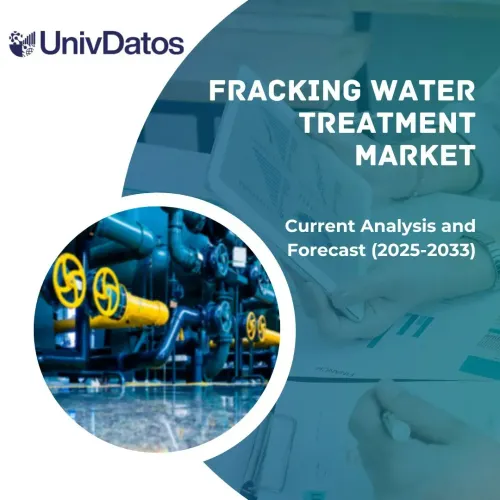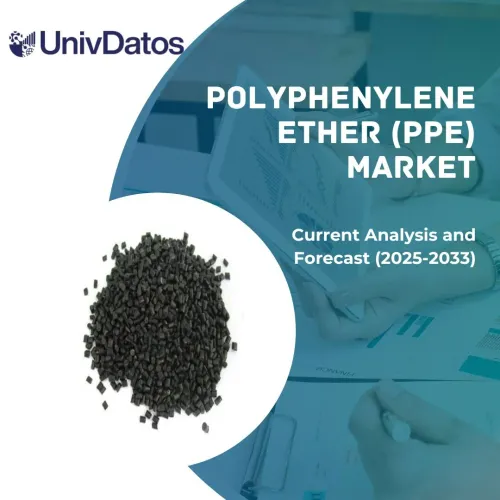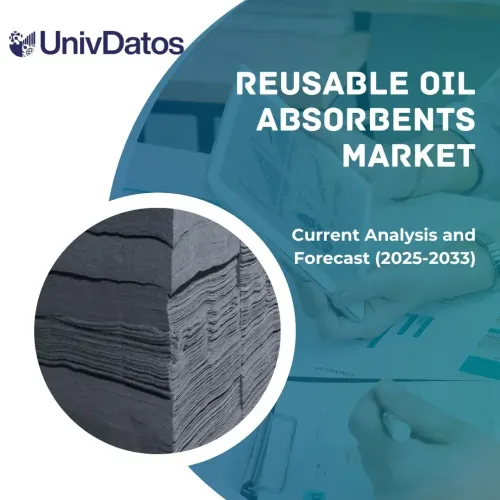- Home
- About Us
- Industry
- Services
- Reading
- Contact Us
Carbon Black Market: Current Analysis and Forecast (2021-2027)
Emphasis by Process Type (Furnace Black, Channel Black, Acetylene Black, Thermal Black, and Others); Grade (Specialty Grade, Conductive Grade, and Others); Application (Rubber Reinforcement, Paints & Coatings, Plastics, Battery Electrodes, Inks & Toners, and Others); and Region and Country
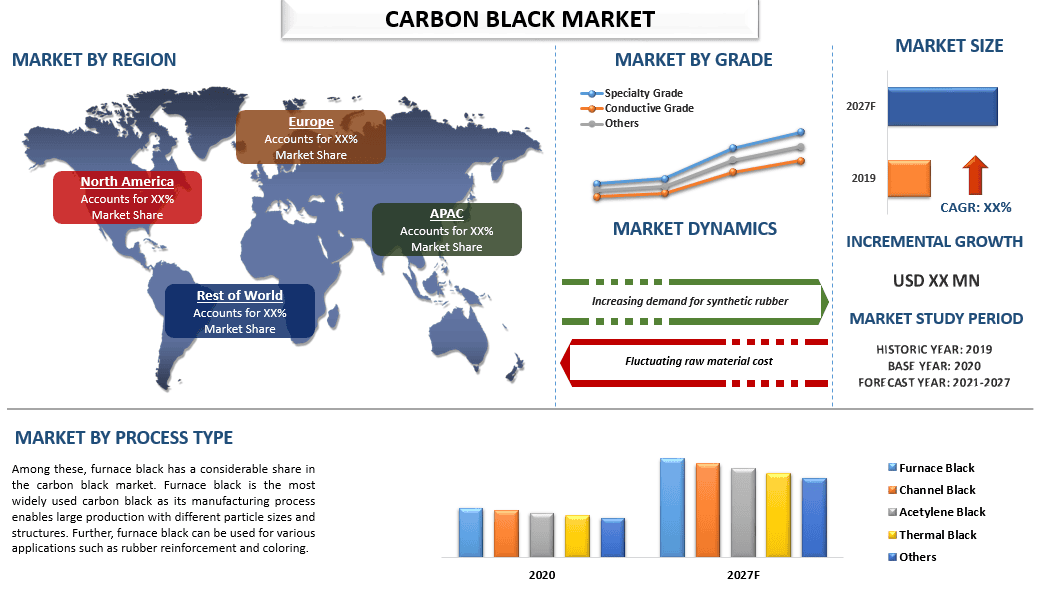
The global carbon black market is likely to showcase a growth of around 5% during the forecast period. Carbon black is a form of para crystalline carbon, which contains around 95% of pure carbon and enhances the physical and mechanical properties of the material which makes the end product more effective. Also, it can absorb UV light and converts it into heat, therefore, finds its application in insulating wires and cables. Moreover, it is used in the production of a wide range of rubber products and pigments. It also serves as a cost-effective rubber reinforcing agent used in tires. Further, carbon black has a huge demand from tire and construction & manufacturing industries, where it is used to provide strength to industrial rubber compounds and other equipment. Additionally, it has physical properties such as color stability, solvent resistance, and thermal stability, owing to these properties it is widely used in the paint and coating industries. Moreover, several companies are doing innovations for using carbon black in new tires. For instance, in November 2021, Bridgestone Corp. and Michelin Group established a dedicated website as a communications platform for their joint initiative to increase the use of recovered carbon black (rCB) in new tires. Using rCB in new tires would cut CO2 emissions from carbon black production by 85% compared with virgin materials. Owing to such factors, the demand for carbon black is likely to grow in the near future.
Insights Presented in the Report
“Amongst process types, furnace black has a considerable share in the carbon black market”
Based on process type, the market is categorized into furnace black, channel black, acetylene black, thermal black, and others. Among these, furnace black has a considerable share in the carbon black market. Furnace black is the most widely used carbon black as its manufacturing process enables large production with different particle sizes and structures. Further, furnace black can be used for various applications such as rubber reinforcement and coloring.
“Amongst applications, rubber reinforcement has a prominent share in the carbon black market”
Based on application, the market is categorized into rubber reinforcement, paints & coatings, plastics battery electrodes, inks & toners, and others. Among these, rubber reinforcement held a prominent share in the global carbon black market. Reinforced rubber products combine a rubber matrix and carbon black as a reinforcing material so that they can achieve high strength to flexibility ratios, higher resistance to mechanical damage, improved traction, and better stability against additional motion-induced loads. Due to this, reinforcement rubber is widely used in the tire industry as it is better suited to meet the increasingly stringent specifications of high-performance tires. Further, in the automotive industry, rubber reinforcement founds application in belts, hoses, and gaskets. Therefore, growth in the tire industry and replacement of automotive components are some of the key factors for its considerable position in the market
“Asia-Pacific accounted for a considerable share in the global carbon black market”
For a better understanding of the market adoption of carbon black, the market is analyzed based on its worldwide presence in the countries such as North America (United States, Canada, Rest of North America), Europe (Germany, France, United Kingdom, Italy, Spain, Rest of Europe), Asia-Pacific (China, Japan, India, Australia, Rest of Asia-Pacific), and Rest of the World. Asia-Pacific held a prominent share in the carbon black market. Owing to its large tire manufacturing industry and largest automobile production base across the globe. For instance, tire manufacturers like Bridgestone, Yokohama, Kumho, Hankook, Triangle, Apollo, and MRF are among the largest producer of tires, globally. Further, the region is the largest producer of footwear in the world, with countries like China, Vietnam, Indonesia, and India having a considerable market share. Therefore, the region has a large number of synthetic rubber manufacturing facilities in order to make a strong supply chain and take advantage of lower manufacturing costs. As a result, high consumption of carbon black by these facilities.
Reasons to buy this report:
- The study includes market sizing and forecasting analysis validated by authenticated key industry experts
- The report presents a quick review of overall industry performance at one glance
- The report covers an in-depth analysis of prominent industry peers with a primary focus on key business financials, product portfolio, expansion strategies, and recent developments
- Detailed examination of drivers, restraints, key trends, and opportunities prevailing in the industry
- The study comprehensively covers the market across different segments
- Deep dive country-level analysis of the industry
Customization Options:
The global carbon black market can further be customized as per the requirement or any other market segment. Besides this, UMI understands that you may have your own business needs, hence feel free to connect with us to get a report that completely suits your requirements.
Table of Content
Research Methodology for Carbon Black Market Analysis (2019-2027)
Analyzing the historical market, estimating the current market, and forecasting the future market of carbon black, three major steps are undertaken to create and analyze its adoption across the globe. Exhaustive secondary research was conducted to collect the historical market numbers and estimate the current market size. Secondly, to validate these insights, numerous findings and assumptions were taken into consideration. Moreover, exhaustive primary interviews were also conducted, with industry experts across the value chain of the carbon black industry. Post assumption and validation of market numbers through primary interviews, we employed a bottom-up approach to forecast the complete market size. Thereafter, market breakdown and data triangulation methods were adopted to estimate and analyze the market size of segments and sub-segments of the industry pertains to. Detailed methodology is explained below:
Seek More Details About Research Methodology
Analysis of Historical Market Size
Step 1: In-Depth Study of Secondary Sources:
Detail secondary study was conducted to obtain the historical market size of carbon black through company internal sources such as annual reports & financial statements, performance presentations, press releases, etc., and external sources including journals, news & articles, government publications, competitor publications, sector reports, third-party database, and other credible publications.
Step 2: Market Segmentation:
After obtaining the historical market size of the carbon black market, we conducted a detailed secondary analysis to gather current market insights and share for different segments & sub-segments for major regions. The major segment is included in the report by process type, grade, and application. Further regional and country-level analyses were conducted to evaluate the overall adoption of carbon black globally.
Step 3: Factor Analysis:
After acquiring the historical market size of different segments and sub-segments, we conducted a detailed factor analysis to estimate the current market size of carbon black. Further, we conducted factor analysis using dependent and independent variables such as increasing demand for high-performance tires and better quality products for insulation. A thorough analysis was conducted for demand and supply-side scenarios considering an increasing investment, top partnerships, mergers and acquisitions, business expansion, and product launches in the carbon black industry.
Current Market Size Estimate & Forecast
Current Market Sizing: Based on actionable insights from the above 3 steps, we arrived at the current market size, key players in the global carbon black market, and market shares of each segment. All the required percentage shares split, and market breakdowns were determined using the above-mentioned secondary approach and were verified through primary interviews.
Estimation & Forecasting: For market estimation and forecast, weights were assigned to different factors including drivers & trends, restraints, and opportunities available for the stakeholders. After analyzing these factors, relevant forecasting techniques i.e., the bottom-up approach were applied to arrive at the market forecast to 2027 for different segments and subsegments across the major regions globally. The research methodology adopted to estimate the market size encompasses:
- The industry’s market size, in terms of value (US$) and the adoption rate of carbon black across the major markets
- All percentage shares, splits, and breakdowns of market segments and sub-segments
- Key players in the carbon black market. Also, the growth strategies adopted by these players to compete in the fast-growing market
Market Size and Share Validation
Primary Research: In-depth interviews were conducted with the Key Opinion Leaders (KOLs) including Top Level Executives (CXO/VPs, Sales Head, Marketing Head, Operational Head, Regional Head, Country Head, etc.) across major regions. Primary research findings were then summarized, and statistical analysis was performed to prove the stated hypothesis. Inputs from primary research were consolidated with secondary findings, hence turning information into actionable insights.
Split of Primary Participants by Stakeholders and Regions
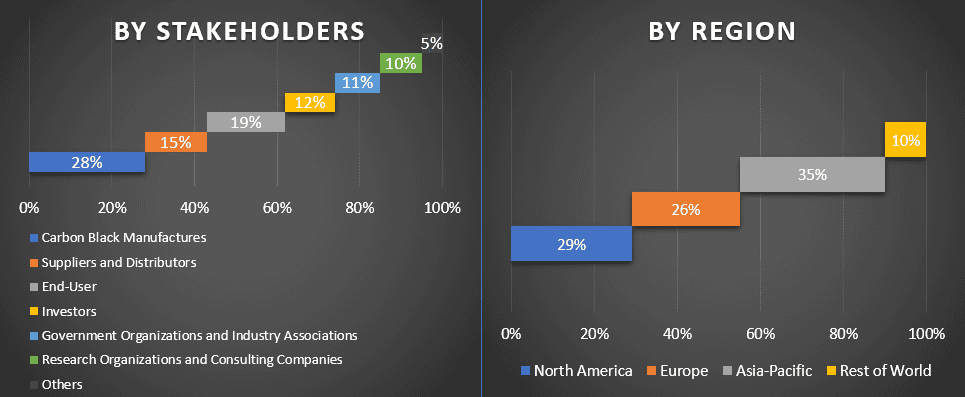
Market Engineering
The data triangulation technique was employed to complete the overall market estimation and to arrive at precise statistical numbers for each segment and sub-segment of the global carbon black market. Data was split into several segments & sub-segments post studying various parameters and trends in the area of process type, grade, and application.
The main objective of the carbon black market study
The current & future market trends of global carbon black were pinpointed in the study. Investors can gain strategic insights to base their discretion for investments on the qualitative and quantitative analysis performed in the study. Current and future market trends would determine the overall attractiveness of the market at a country level, providing a platform for the industrial participant to exploit the untapped market to benefit as a first-mover advantage. Other quantitative goals of the studies include:
- Analyze the current and forecast market size of carbon black in terms of value (US$). Also, analyze the current and forecast market size of different segments and sub-segments
- Segments in the study include the area of process type, grade, and application
- Defined analysis of the regulatory framework for the carbon black industry
- Analyze the value chain involved with the presence of various intermediaries, along with analyzing customer and competitor behaviors of the industry
- Analyze the current and forecast market size of carbon black for the major countries
- Major regions/countries analyzed in the report include North America (United States, Canada, and the Rest of North America), Europe (Germany, France, United Kingdom, Italy, Spain, and the Rest of Europe), Asia-Pacific (China, Japan, India, Australia, and Rest of APAC), and Rest of the World
- Company profiles of the carbon black market players and the growth strategies adopted by them to sustain the growing market
- Deep dive country-level analysis of the industry
Related Reports
Customers who bought this item also bought




